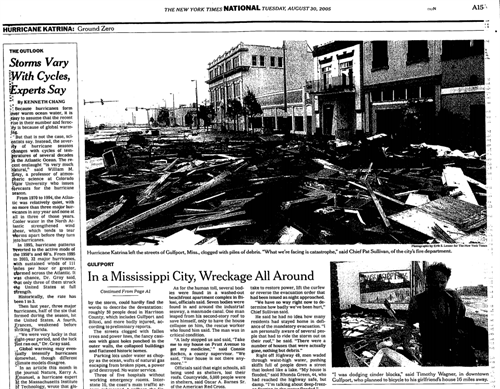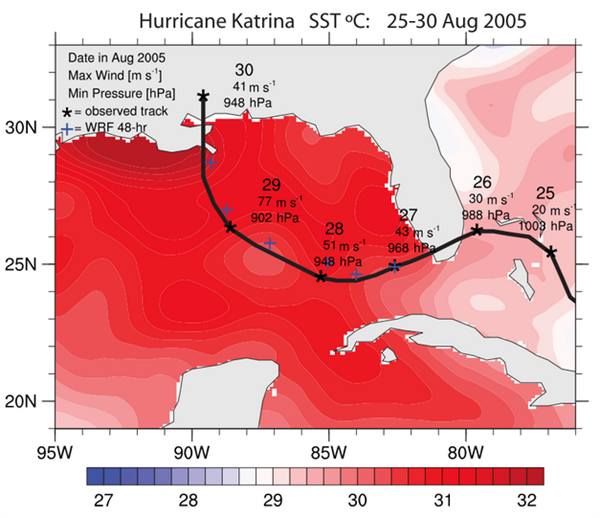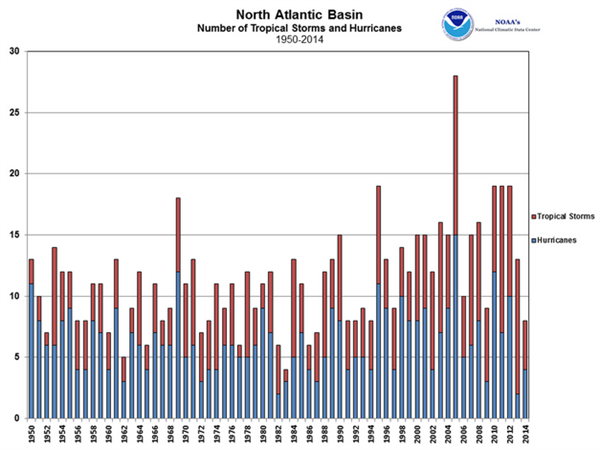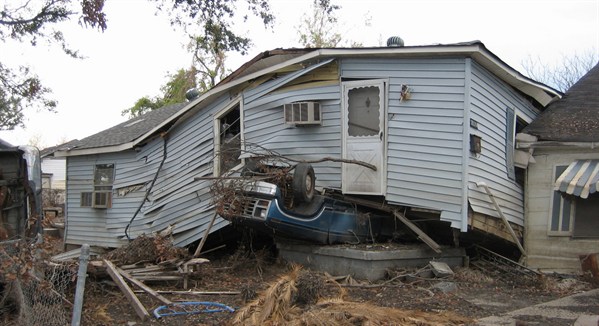Shortly after 10am on 29th August 2005, Hurricane Katrina tore through the city of New Orleans, a vibrant port in the US state of Louisiana. Extreme winds and heavy flooding cost more than 1,800 people their lives and caused an estimated $108bn in damages.
As images of the destruction beamed across the world, the media began asking questions about how far the scenes were a product of our own actions. The New York Times said:
‘With one American city swamped by one great hurricane and then by another one only a month later â?¦ it is no surprise that debate has flared over the role of global warming.”
Or as the BBC’s Richard Black put it:
“Hurricanes and global warming – a link? Here’s a recipe for an explosive news cocktail.”
As well as kickstarting an energetic media and public interest in extreme weather and climate change, Katrina also put pressure on the science community to provide answers.
Carbon Brief spoke to some scientists working in the field about what has and hasn’t been learned in the ten years since Hurricane Katrina made its destructive mark on Louisiana.

New York Times, Aug 30th 2005
A storm brewing
‘Hurricane’ is the name given to a tropical storm that forms in the North Atlantic or Northeast Pacific, with wind speeds reaching 33 metres per second or more.
Storms this big are called different things depending on where in the world they form. In the Northwest Pacific they are known as typhoons, while in the Indian Ocean they are cyclones.
There are five categories of hurricane. Storms with wind speeds above 67 metres per second classify as category five. Those between 56 and 67 metres per second fall into category four.
When it made landfall in Louisiana, hurricane Katrina had a sustained wind speed of about 55 metres per second, making it a strong category three storm.
Warmer seas, stronger storms
Hurricanes form over warm water near the equator. A long time before Katrina, scientists suspected that a warming ocean could provide extra fuel for hurricanes, making them stronger than they would otherwise have been.
Modelling studies demonstrated the relationship between sea surface temperatures and hurricane strength, while others looked at observations of hurricane patterns over time.

Observed sea surface temperature in C with the track taken by Katrina overlaid (black line). Asterisks to indicate locations on 25 to 30 August 2005. Trenberth et al., ( 2005)
In 2005, Prof Peter Webster from the Georgia Institute of Technology published his team’s findings that the number of category 4 and 5 storms globally rose between the 1970s and the early 2000s, from about 50 to 90 over a five-year period.
Coming a month after Katrina, the paper got a fair amount of media attention. “Study attributes stronger storms to warmer seas”, read a The New York Times headline.
10 years on
It’s been notoriously difficult to identify trends in past hurricane activity.
Part of the difficulty is ‘miserable’ global historical hurricane records, says Prof Kevin Trenberth from the US National Center for Atmospheric Research. Data quality improved with the advent of satellites but the record is still very patchy.
A recent paper found that once you account for improvements in satellite data since the 1970s, the global rise in strong hurricanes may not be as sharp as it first seemed.
The best records are in the North Atlantic, where surveillance aircraft have complemented the satellite data since the 1940s, says Trenberth. There, we’ve seen a substantial increase in Atlantic hurricane activity over the past 35 years. But, he adds:
“The other thing that gets complicated in this is for so-called ‘landfalling’ hurricanes. There are much better records of landfalling hurricanes that go back to the 1850’s, maybe. But there are so few, they make up only 2-3% of the total number.”
Historical records focus on the peak wind speed when a storm makes landfall, but other things like size, duration and path over the ocean affect how damaging it is, says Trenberth.

North Atlantic Tropical Cyclone Count 1950-2014. Source: NOAA
Just to complicate matters further, natural fluctuations in the climate system cause variability in tropical storm activity from one year to the next, explains Dr Jim Kossin, atmospheric scientist at NOAA’s Center for Weather and Climate. He tells Carbon Brief:
“This season is certainly very quiet in the Atlantic, there’s no doubt about that. Now we have a pretty good idea that this is being driven by the developing El Nino, and we understand all of that fairly well.”
Other natural cycles affect hurricane activity from one decade to the next. That’s why we have to be careful to look at hurricane trends, or any aspect of the climate system, from a slowly evolving point of view, says Kossin, the rest of it is just noise.
Stronger hurricanes, fewer overall
Separating any past global warming ‘signal’ from the background ‘noise’ has certainly been problematic. But as more data becomes available, the expectation from scientists is that the number of strong hurricanes will increase as the climate warms.
The latest report by the Intergovernmental Panel on Climate Change says it’s more likely than not we’ll see more intense hurricanes in the North Atlantic and western North Pacific Oceans, but a lack of data means the same can’t be said of other regions just yet.
Most scientists expect the increase in the number of strong hurricanes as the climate warms to be at the expense of smaller ones, meaning fewer overall. The reason for this is that big storms leave a cold wake behind, making the environment less favorable for the next one.
Big strides forward
Wind speed is certainly a big part of how damaging a hurricane turns out to be. The force exerted increases disproportionately with the wind speed, which means 10% rise in wind speed translates to a 33% increase in destructiveness, all things being equal.
But there are many more pieces to the puzzle, says Kossin. The biggest strides in the last 10 years have been in understanding all those other factors, he tells Carbon Brief:
“It’s not as simple as just saying that the warmer the oceans, the stronger the hurricanes are, or the more frequent they are. It turns out to be much more complex than that.”
Rising sea levels mean that when a hurricane hits land, the storm surge it produces is more likely to overwhelm coastal defences and cause flooding.
This is part of what made Katrina so damaging. At the time, the BBC reported that storm surges had caused flooding several kilometres inland in some places.
The same has been true of more recent tropical storms, says Dr Friederike Otto from the University of Oxford in the UK. She tells Carbon Brief:
“With hurricane Sandy and [Typhoon] Haiyan, scientists found little contribution [from human activity] to the storm itself, but the main role of climate change was through the higher sea levels.”
Scientists also know that a warmer atmosphere can hold more moisture, meaning there’s more water available to fall as rain when a storm hits. A recent study showed how heavy rainfall alongside a storm surge has amplified flood risk in many major US cities in the last century.
This doesn’t mean there wouldn’t have been heavy rains and flooding if climate change wasn’t happening, says Trenberth. But, he adds:
“But sometimes it can make the difference … It’s the straw that breaks the camel’s back. It’s the little bit extra from climate change that exceeds the values that were planned for and things break.”
Human contribution
While knowing how hurricanes in general may change in a warmer world is important, the questions asked after a disaster like Katrina tend to be far more specific.
How much worse has climate change made the event we’ve just experienced?
Prof Ted Shepherd, from the University of Reading in the UK, says:
“For a long time, the standard answer of climate scientists to an extreme event was “we can’t attribute single events to climate change”, which when you think about it is an incredibly naive position. For example, it is generally not possible to attribute a particular death by lung cancer to smoking even for a heavy smoker, but the effect on risk is beyond doubt.”
The pressure to say something more specific about Katrina gave the scientific community a new steer, says Otto. Scientists began pinpointing how climate change has altered the chances of a particular event happening. This is known as “single event attribution”.
Such studies were around before Katrina. A paper in 2004 found that climate change had made the European heatwave in 2003 twice as likely, for example. (Incidentally, an update to that study found the risk of ‘extremely hot’ summers is now ten times greater than when the 2003 heatwave struck.)
But after hurricane Katrina, attribution stepped up a gear. Otto says:
“It was realised in the scientific community that we really need to do event attribution if we want to be able to say something quantitative when people ask the question about the role of climate change.”
Some recent examples include a study of the heatwave across Europe in July, which found global warming made such an event at least twice as likely over much of the continent.
After heavy rain in the winter of 2012 in the UK led to widespread flooding, a study found that climate change had made such rainfall 25% more likely.
Hurricane Katrina cost more than 1,800 people their lives during and caused an estimated $18bn in damages. Credit: Infrogmation of New Orleans/Flickr
“Something of a revolution”
If attribution studies had been available during Katrina, what might they have told us?
They may have stopped the media discussion from taking such a binary approach to the question of climate change’s role, Otto says:
“I think if we would have been able to provide attribution analyses in the direct aftermath of Katrina it would have been very powerful, and allowed maybe for the discussion to focus less on blaming climate change or denying its existence.”
The way that attribution allows scientists to talk about climate change’s making a specific event more or less likely has been “something of a revolution”, says Shepherd. He tells Carbon Brief:
“It changes the question from “What does this event tell us about climate change?” to “What does climate change tell us about this event?”
Unfortunately, it’s not always as simple as that. Not for hurricanes at least.
While the human contribution to heatwaves and heavy rainfall are relatively straightforward to untangle, for hurricanes it’s far more difficult.
One reason is the lack of good data. But another is that the many different elements that interact in hurricanes can sometimes pull in opposite directions. Prof Myles Allen, head of the climate dynamics group at the University of Oxford, tells Carbon Brief:
“While research at the time of Katrina pointed to sea surface temperatures and sea level as causing damage and having a human contribution, other researchers suggested warming sea surface temperatures elsewhere and changing atmospheric vertical structure may have had a countervailing effect, making the overall impact of human activity on Katrina unclear.”
Q & A
As far as attribution goes, the fact that it might pose a complicated question shouldn’t mean we avoid answering it altogether, says Shepherd. He tells Carbon Brief:
“These are extremely challenging scientific questions, but we cannot just wait for more data or better models – people need some kind of answer now â?¦ We have to give the best answers we can, with the appropriate caveats.”
But Kossin warns that the different elements of hurricanes can lead to confusion, adding:
“I’m not saying there’s never been a compelling attribution study for a single event. I think we’ve got to the point now with heatwaves where we can start to talk about quantifying how much stronger it is because of climate change. But heatwaves are a much different animal to tropical cyclones, and I don’t think we’ve quite gotten there yet.”
While formal attribution studies might be some way off, this doesn’t mean scientists can’t say anything with confidence about hurricanes like Katrina and climate change, Kossin says:
“I think what we need to be saying is that we imagine these types of events to be more likely, and will continue to be more likely, into this century. And I, frankly, think that’s quite alarming all by itself.”
Being careful to talk about probabilities, while explaining natural variability, data quality and the different rules for different types of extreme weather all make for a very nuanced message.
Are the media getting it right?
Dr James Painter from the Reuters Institute for the study of journalism at the University of Oxford tells Carbon Brief:
“My impression is that much of the mainstream media organisations are becoming a lot more careful in how they describe the link between single extreme weather events and man-made climate change.”
Prof Kerry Emanuel from the Massachusetts Institute of Technology tells Carbon Brief:
“I perceive that the media are beginning to understand some of the subtleties of the problem. For example, it is not meaningful to talk about frequency and intensity as separate issues, and more reporters are understanding that the main issues are the frequency of the rarer high intensity events, storm surges, and rainfall. Hurricane rain is finally starting to get more attention, as it deserves.”
Weighing up
A lot has changed since Katrina.
Science can tell us more about how climate change is altering how often the world bears the brunt of such a destructive force. The media is beginning to reflect a more nuanced discussion of how climate change is implicated in extreme weather.
But other areas have seen far too little progress. Some of the mistakes that made New Orleans so vulnerable in the first place are being repeated, Trenberth tells Carbon Brief:
“The engineers came back in and restored the levies, more or less rebuilding them to withstand a category three storm. And they resettled areas that are below sea level … and so I don’t know that enough lessons have been learned.”
The rising risks from hurricane damage should be ramping up pressure on governments, says Trenberth, both to tackle climate change and build resilience. Ten years on from Katrina, the science has moved on but our response appears to be falling woefully short.


